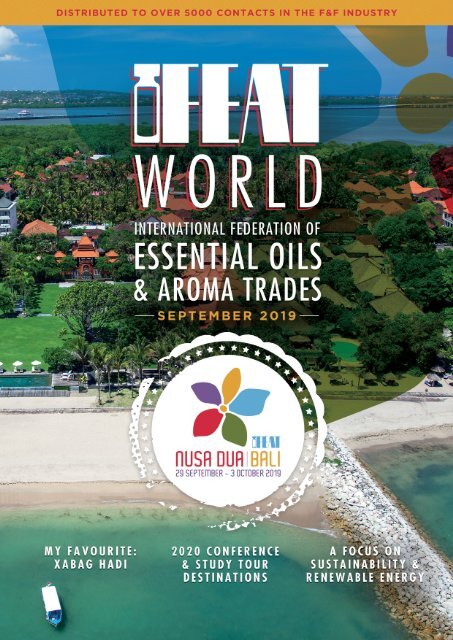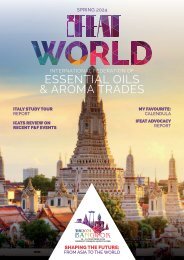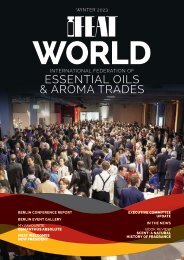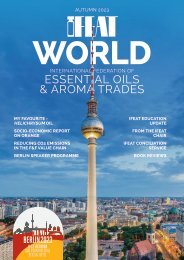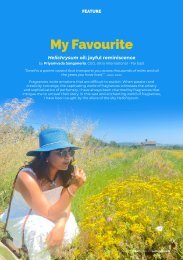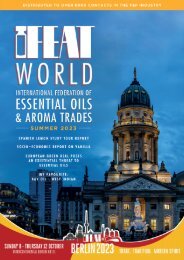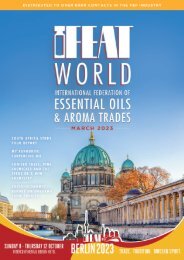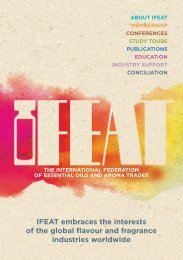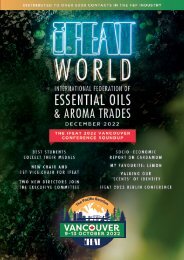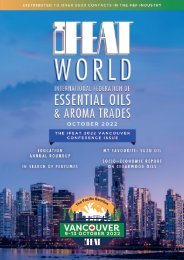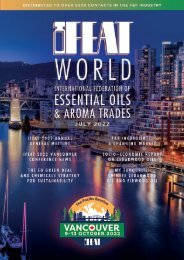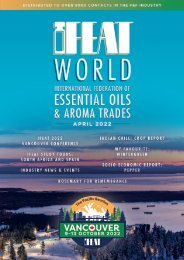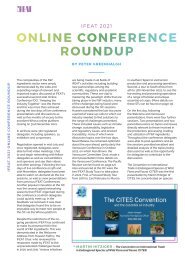Create successful ePaper yourself
Turn your PDF publications into a flip-book with our unique Google optimized e-Paper software.
70<br />
3<br />
1<br />
Berjé has strived for excellence as a supplier and<br />
producer of Essential Oils, and Aromatic Chemicals<br />
since our early days in New York City. In those six<br />
decades Berjé has built an inventory of over 3000<br />
ingredients that covers the esoteric to the everyday.<br />
Rigorous QC standards, comprehensive traceability<br />
programs, and our recent SQF certification have<br />
established Berjé as a top tier distributor.<br />
With that foundation Berjé is breaking new ground on<br />
improving the industry’s standard of service. Coupled<br />
with Berjé Trakia, a European rose and lavender<br />
production facility, our global network of partners<br />
gives us the reach to sell in over sixty countries on six<br />
continents. As we further our commitment to promoting<br />
environmentally stable solutions, Berjé guarantees the<br />
quality of the past and the best practices of a<br />
sustainable business future.<br />
Berjé Inc. an SQF Level 3 Quality Certified Supplier<br />
700 BLAIR ROAD, CARTERET, NJ 07008 USA<br />
+1 973 748 8980 | WWW.BERJEINC.COM
WORLD 3<br />
for these will take place at the venue,<br />
on the morning of the respective<br />
sessions, on a first come, first served<br />
basis.<br />
Welcome to Bali!<br />
FROM THE JOINT<br />
CONFERENCE CHAIRMEN<br />
RAVI SANGANERIA<br />
AND STEPHEN PISANO<br />
On behalf of the Executive Committee,<br />
we would like to extend a warm<br />
welcome to all delegates attending<br />
the IFEAT conference being held in<br />
Nusa Dua, Bali. It’s hard to believe the<br />
conference is finally here. This highly<br />
anticipated event, which took three<br />
years to plan, has finally come to<br />
fruition.<br />
Since registration opened in<br />
April this year, we have received<br />
an overwhelming response. The<br />
preparations have been in full swing.<br />
In addition to a lot of liaison work, the<br />
Bali Conference Committee, Melali Bali<br />
DMC, and the local IFEAT teams have<br />
worked round the clock to ensure that<br />
your experience is a seamless and<br />
enriching one.<br />
We are pleased to report that this will<br />
be the highest attended conference<br />
in IFEAT’s history, and we would<br />
like to thank the membership and<br />
our non-member delegates for this<br />
overwhelming response!<br />
Nusa Dua is located on Bali’s most<br />
southern peninsula and is the capital<br />
of Bali Province. Translated from<br />
Indonesian, Nusa Dua literally means<br />
“Two Islands”. But the name actually<br />
refers to two small raised headlands<br />
just off the coast of the peninsula.<br />
A Hindu shrine (Pura) called Nusa<br />
Dharma stands on one of these<br />
islands. Tan Sie Yong of Chinese<br />
descent built this in 1948.<br />
We would like to invite all delegates<br />
to join us in a Balinese style<br />
procession to pay homage in a local<br />
temple near the hotel at the start of<br />
the Welcome Reception on Sunday<br />
29th <strong>Sept</strong>ember. This is very much a<br />
tradition in Bali, to give thanks and<br />
wish us all a successful conference!<br />
The procession will depart from the<br />
reception venue, the Unity Garden,<br />
immediately after our welcome<br />
speech at approximately 6.15pm.<br />
Our “Naturals of Asia" theme will focus<br />
on essential oils from the surrounding<br />
geographical area making Bali the<br />
logical venue for our conference. The<br />
Conference programme has been<br />
finalised and published. If you haven't<br />
had a chance, please take a moment<br />
and familiarise yourself with it.<br />
We have slightly deviated from our<br />
standard format in order to ensure<br />
optimum utilisation of time for our<br />
delegates. Lecture sessions will<br />
be held from 9am until 11am from<br />
Monday 30th <strong>Sept</strong>ember to Thursday<br />
3rd October <strong>2019</strong>. In addition, the<br />
trade exhibition will be open every<br />
day from 11am until 5pm. Considering<br />
the immense popularity of the<br />
roundtables in the last two years,<br />
this year we have incorporated two<br />
roundtable sessions. The registrations<br />
We would like to extend our sincere<br />
thanks to all the companies who have<br />
sponsored events this year. They are:<br />
Indesso, Moellhausen, Arora Aromatics,<br />
Citrus and Allied Essences, Australian<br />
Botanical Products, Herbochem<br />
Industries, Jiangxi Huangyan<br />
Perfumery Co. Ltd , Fujian Green<br />
Pine Co Ltd, Neeru Menthol Private<br />
Limited, Saptagir Camphor Limited,<br />
Tech-Vina TSC, Tanemura & Co Ltd,<br />
The Lebermuth Company, FGF Trapani,<br />
AOS Products, Quintis (Australia) PTY<br />
Ltd, Laboratoire Phyto-Chemia, Eternis,<br />
Ultra International B.V., Karnataka<br />
Aromas, Alta Oils Ltd, Fragrand<br />
Aromas, Ayuroma Centre, and Norex<br />
Flavours Private Limited.<br />
To our Local Organising Committee;<br />
Ali Besar (CV Aroma), Robby Gunawan<br />
(PT Indesso), Sandeep Tekriwal (Van<br />
Aroma), Feri Agustian Soleh (PT<br />
Indesso), Petrus Arifin (PT Karimun<br />
Kencana Aromatics) - all of whom<br />
are experts on Bali and lead us to the<br />
venues we are all enjoying this week<br />
- we thank you for your guidance and<br />
simplifying our path. It has been a<br />
complete pleasure working with and<br />
getting to know you all.<br />
To our Bali Conference Committee;<br />
Raul Amigo, Antonella Corleone, Jens-<br />
Achim Protzen, Susumu Tominaga,<br />
and Winnie Yeung (Co-Option), we<br />
wish to thank you for all your time,<br />
expertise, advice, and for travelling to<br />
Bali multiple times during the planning<br />
stages of this conference.<br />
To the IFEAT team; Sarah, Tina,<br />
Louise and Ronit, we could not have<br />
accomplished this without your<br />
expertise. It has been a complete<br />
pleasure working with all of you, IFEAT<br />
is very fortunate to have you all!<br />
To each of our delegates, we wish you<br />
all a successful conference and we<br />
hope you enjoy all that Bali has to offer.<br />
Sincerely...<br />
Ravi Sanganeria and Stephen Pisano<br />
IFEAT Bali Conference<br />
Committee Co-Chairmen<br />
For editorial and advertisement enquiries,<br />
please email the editor, Tina Carne, at:<br />
ifeatworld@ifeat.org
4<br />
WORLD<br />
WORKING TOWARDS A MORE SUSTAINABLE CONFERENCE<br />
In the delegate bags, attendees will<br />
find a reusable, non-plastic water<br />
container which can be refilled<br />
throughout the day at the water<br />
coolers which will be placed around<br />
the venue. We are hoping delegates<br />
will take advantage of this in order<br />
to eliminate the need to purchase<br />
plastic bottled water which will<br />
reduce the amount of waste created<br />
at the Conference.<br />
Each year a large number of<br />
delegate bags are left at the venue,<br />
but this year they will not be wasted<br />
as we will be arranging for any<br />
leftover bags, notepads, pens, etc., to<br />
be delivered to the children in local<br />
schools and orphanages in the rural<br />
areas of east and north Bali. IFEAT<br />
will also be using, where possible,<br />
banners and graphics that can be<br />
easily recycled.<br />
Our partners have their own<br />
sustainable policies too.<br />
In order to reduce water pollution<br />
and save water, The Mulia Resort<br />
will only change the bed sheets and<br />
linens in the rooms daily if the guest<br />
WORKING TOWARDS A MORE<br />
SUSTAINABLE<br />
CONFERENCE<br />
At this year’s IFEAT Conference in Bali, we are making a few changes so that<br />
we can begin to create a more sustainable event moving forward.<br />
has requested it. Another initiative<br />
they use is to switch off lights in<br />
certain areas near guestrooms when<br />
rooms are not occupied.<br />
The installation of hydrojet<br />
equipment in some of the swimming<br />
pools keeps the water oxygenated<br />
thereby eliminating the need to use<br />
harsh chemicals.<br />
Paper straws and lemongrass<br />
stirrers are being used at the IFEAT<br />
Welcome Reception in order to cut<br />
down on plastic use and the Mulia is<br />
currently developing a programme<br />
to use recyclable materials (made<br />
from cassava) instead of plastic bags,<br />
takeaway food boxes and takeaway<br />
drinking cups.<br />
The hotel is working with the<br />
local community to maintain its<br />
surrounding environment.<br />
In terms of our evening events, the<br />
venues we have chosen have their<br />
own environmental strategies. Taman<br />
Bhagawan, where the IFEAT Dinner<br />
will take place, and Puri Bhagawan,<br />
where we will hold the Closing<br />
Banquet, are owned by the same<br />
people.<br />
In their efforts to be responsible<br />
about waste management -<br />
reducing waste into landfill and<br />
promoting composting - they<br />
partner with Eco Bali Recycling to<br />
provide training to their team and<br />
also the right waste and recycling<br />
solutions for their operations.<br />
They have a “two bin” rubbish<br />
disposal system consisting of a<br />
green bin for paper and a red bin for<br />
glass, metal, plastic and other nonorganic<br />
waste.<br />
Taman Bhagawan and Puri<br />
Bhagawan also use a composting<br />
method where organic kitchen<br />
waste goes through a unique<br />
layering process installed in their<br />
central kitchen production facility.<br />
We encourage you to help us<br />
to develop and maintain a more<br />
sustainable IFEAT Conference for<br />
the future.
6<br />
WORLD<br />
USE OF DISTILLATION BIOMASS<br />
WASTE TO PRODUCE<br />
USE OF DISTILLATION BIOMASS WASTE TO PRODUCE RENEWABLE ENERGY<br />
Distilleries all over the industry are<br />
faced with the same problem: due<br />
to low yields, they have to process<br />
hundreds of tons of biomass to<br />
produce essential oils, and in many<br />
cases have no easy options to<br />
dispose of this biomass.<br />
On the other hand, the distilleries<br />
also need a huge amount of energy,<br />
and have a hard time finding<br />
renewable sources for this energy.<br />
DISTILLERY<br />
WASTE LAND<br />
RENEWABLE<br />
ENERGY<br />
Methanisation could be a good<br />
option to tackle those two problems.<br />
Methanisation is an industrial process<br />
that uses a variety of biomass waste<br />
(including most distillation waste<br />
- except wood, farm waste and<br />
manure, etc.) that enters an anaerobic<br />
biodigester, where the biomass<br />
is consumed by methanogenic<br />
bacteria. These bacteria decompose<br />
the biomass into biogas which is<br />
composed of approximately 60%<br />
methane gas and 40% CO 2, as<br />
well as minerals - NPK (nitrogen,<br />
phosphorus, and potassium).<br />
The biogas is then used to produce<br />
energy. Its best use is in the form<br />
of thermic energy, for example in<br />
a boiler, as it allows a much higher<br />
energy output yield of around 85%.<br />
It can also be used to produce<br />
electricity, being injected in a motor<br />
or a turbine and will deliver around<br />
40% yield in that case.<br />
The minerals come in the form of<br />
slurry or dirt, which constitutes a<br />
very good fertiliser that can be used<br />
to develop new crops, or it can be<br />
sold, especially when the biomass<br />
input is a mixture of animal and<br />
vegetal biomass.<br />
NELIXIA’S<br />
BIODIGESTER<br />
PROBABLY THE MOST BEAUTIFUL<br />
BIODIGESTER ON EARTH
WORLD 7<br />
Our company, like many in the<br />
industry, was faced with the<br />
following situation: accumulation<br />
of biomass waste with no<br />
satisfactory way to dispose of it and<br />
unfortunately it was necessary to<br />
use fossil energy as no renewable<br />
energy was available.<br />
To tackle this situation, we decided<br />
to invest in a 600 m 3 biodigester<br />
in which to put our biomass waste<br />
(cardamom, pink peppercorn, etc.),<br />
cow manure that we collected from<br />
neighbouring farms, along with fat<br />
which is the residue from a biodiesel<br />
factory.<br />
We went for an efficient cylindrical<br />
biodigester, agitated and heated<br />
efficiently by our distillation’s<br />
condensation system, which<br />
produces a much higher output of<br />
biogas per m 3 of infrastructure.<br />
By inputting two tons of biomass<br />
waste, one ton of cow manure and<br />
0.2 tons of fat, we generate biogas<br />
that we use in a dedicated boiler<br />
which helps us substitute the use<br />
of almost 70 gallons of diesel per<br />
day! We also take advantage of<br />
the fertiliser (a by-product) that is<br />
redistributed into our communities<br />
to develop new crops.<br />
Thanks to an investment of<br />
approximately $150,000 (USD) in<br />
this system, we are saving more<br />
than 20% of the fossil energy we<br />
used and are avoiding 1,000 tons<br />
of waste, which would otherwise<br />
go into landfill, thus avoiding huge<br />
releases of methane gas.<br />
Methanisation is a process very<br />
well adapted to a distillery, but it<br />
also requires lots of know-how and<br />
adjustment.<br />
To have an efficient solution,<br />
the biodigester has to be<br />
“homogeneously agitated”, which<br />
can be a challenge for a 600 m 3<br />
cylinder filled with 20% of solid<br />
biomass.<br />
It is also better to warm it. In<br />
distilleries this can be done<br />
efficiently by thermic transfer with<br />
hot water from condensation.<br />
Another challenge is the presence<br />
of sulphuric gas in the biogas,<br />
which is deadly and very corrosive,<br />
but natural solutions exist to<br />
eliminate it, for example promoting<br />
the development of bacteria that<br />
eat the sulphuric acid and use the<br />
oxygen, to produce precipitate<br />
sulphuric acid.<br />
We would advise anyone interested<br />
in this process to follow similar<br />
projects with real experts, because<br />
biodigesters have to be tailor-made<br />
depending on the selected inputs<br />
and outputs, and obvious security<br />
issues.<br />
This was the way we solved our<br />
biomass disposal and fossil use<br />
situation, whilst developing a very<br />
carbon positive approach because<br />
methane gas has 21 times more<br />
greenhouse effect than CO 2.<br />
I encourage everyone to work on<br />
their waste and energy, to form<br />
together an environmentally<br />
friendly industry!<br />
by M. Jean-Marie Maizener<br />
Co-founder and Chief Operating<br />
Officer of Nelixia.<br />
USE OF DISTILLATION BIOMASS WASTE TO PRODUCE RENEWABLE ENERGY<br />
HEATING<br />
SYSTEM<br />
AGITATION<br />
SYSTEM<br />
AGITATION<br />
BLADES
8<br />
WORLD<br />
IFEAT ANNOUNCES 2020<br />
IFEAT STUDY TOUR TO<br />
INDIA<br />
IFEAT ANNOUNCES 2020 IFEAT STUDY TOUR TO INDIA<br />
Following the great success of<br />
the 2013 Study Tour to southern<br />
India, IFEAT is pleased to announce<br />
another Study Tour to India from 12th<br />
to 21st June 2020. IFEAT has worked<br />
closely with the Local Organising<br />
Committee, jointly chaired by<br />
Geemon Korah and Pradeep<br />
Kapoor, to organise this tour. On<br />
this occasion, delegates will be<br />
visiting western, central and northern<br />
India, which have diverse climatic<br />
zones facilitating the production<br />
of a wide range of F&F ingredients<br />
including several varieties of mint,<br />
agarwood (from which oudh is<br />
produced) and sandalwood. The<br />
tour will visit various Indian essential<br />
oil, oleoresin and spice producing,<br />
processing and exporting companies<br />
dealing in a range of flavour and<br />
LOADING MINT<br />
for steam distillation<br />
fragrance ingredients. India has a<br />
history stretching back thousands<br />
of years and during their travels<br />
delegates will be able to see<br />
diverse environments, magnificent<br />
monuments, beautiful scenery and<br />
a rich heritage of traditional music,<br />
dance, crafts, costumes and cuisines.<br />
Participation will be limited to<br />
approximately 40 participants, so<br />
IFEAT members are advised to book<br />
early, as previous recent study tours<br />
were extremely popular and sold<br />
out quickly. Registration will begin in<br />
mid-November <strong>2019</strong> and information<br />
will be available on the IFEAT<br />
website www.ifeat.org. Registration<br />
will be limited to one person per<br />
IFEAT member company.<br />
EMPTYING STILL<br />
after steam distillation<br />
THE INDIA STUDY<br />
TOUR 2020 HAS<br />
A NUMBER OF<br />
OBJECTIVES:<br />
• To gain knowledge of production<br />
and processing facilities of mint<br />
oils, menthol, essential oils,<br />
aroma chemicals and F&F<br />
ingredients produced and<br />
processed in Mumbai, UP (Uttar<br />
Pradesh) and New Delhi and<br />
agarwood and sandalwood in<br />
Assam<br />
• To view field cropping,<br />
traditional field distilleries,<br />
modern distillation and<br />
oleoresin extraction plants<br />
• To visit CIMAP (the Central<br />
Institute of Medicinal and<br />
Aromatic Plants), a major<br />
research institute specialising<br />
in essential oils and medicinal<br />
plants<br />
• Provide delegates with the<br />
opportunity to meet with Indian<br />
producers, processors, importers<br />
and exporters. India is one of the<br />
world’s largest importers,<br />
exporters and consumers of<br />
F&F ingredients<br />
• Tours allow delegates to meet<br />
with other flavour and fragrance<br />
industry professionals from a<br />
variety of countries - on recent<br />
study tours there have been<br />
participants from over 20<br />
countries<br />
• Besides seeing a wide range of<br />
aromatic materials produced in<br />
India, the tour will enable<br />
delegates to experience its rich<br />
culture and history, its diverse<br />
cuisines and its<br />
physical beauty<br />
• To achieve all of this over a<br />
period of eleven days<br />
AGARWOOD PLANTATION<br />
in Assam
WORLD 9<br />
IFEAT ANNOUNCES 2020 IFEAT STUDY TOUR TO INDIA<br />
The map provides a summary of the<br />
places that will be visited including<br />
Mumbai, Lucknow, Bareilly, Agra,<br />
Fatehpur Sikri, Delhi and Guwahati.<br />
The tour starts in Mumbai – India’s<br />
financial and entertainment capital<br />
known as “the city of dreams”,<br />
with registration, a welcome<br />
reception, the tour briefing and a<br />
short tour. The following day we<br />
will visit the operations of two<br />
major Indian companies, Jindal’s<br />
menthol processing operations and<br />
S.H. Kelkar (Keva), India’s leading<br />
fragrance manufacturer. The<br />
next four days will be spent in UP<br />
concentrating on mint production<br />
and processing. An estimated two<br />
million people are employed in<br />
mint production and processing<br />
in UP producing peppermint (M.<br />
piperita), cornmint, (M. arvensis)<br />
and spearmint (M. spicata) oils as<br />
well as other essential oils and<br />
attars. Visits will be made to the<br />
mint production and processing<br />
areas where harvesting will<br />
be in full swing despite the<br />
hot and humid conditions with<br />
temperatures in excess of 40°C.<br />
Traditional distillation operations<br />
will be seen alongside modern<br />
processing operations. Visits are<br />
planned to the production and<br />
processing operations of Kancor<br />
Ingredients, Oriental Aromatics<br />
(formerly Camphor and Allied<br />
Products), Gem Aromatics,<br />
Herbochem, Ashri Menthol and<br />
Jindal. In addition, a visit will be<br />
made to the research headquarters<br />
of CIMAP one of the world’s leading
10<br />
WORLD<br />
multidisciplinary research institutes<br />
into essential oils and medicinal<br />
plants. The final day in UP will be<br />
spent travelling to Agra (“the City of<br />
Love”), visiting various growing and<br />
processing operations on the way.<br />
A highlight of the tour will be dinner<br />
on the hotel terrace overlooking<br />
the Taj Mahal Palace followed by a<br />
very early morning visit to this iconic<br />
UNESCO World Heritage Site. Then<br />
a long coach journey to Delhi, India’s<br />
capital city, via Fatehpur Sikri.<br />
The following day sees another early<br />
departure on a flight to Guwahati in<br />
the north east state of Assam, close<br />
to Bangladesh, Bhutan, China and<br />
Myanmar. During the next two days<br />
delegates will visit Ajmal’s agarwood<br />
and sandalwood plantations, oudh<br />
distillation and processing units,<br />
the R&D centre and there will be<br />
a smelling session. In addition,<br />
visits will be made to neighbouring<br />
educational and medical<br />
establishments. The final day of<br />
the tour will be an early morning<br />
flight back to Delhi, with a visit to<br />
Ultra International’s operations at<br />
Sahibabad followed by a Farewell<br />
Dinner.<br />
IFEAT ANNOUNCES 2020 IFEAT STUDY TOUR TO INDIA<br />
AGARWOOD WITH<br />
PATCHOULI<br />
JINDAL MENTHOL<br />
OPERATIONS
WORLD 11<br />
IFEAT is delighted to announce that we will be back<br />
in Europe in 2020 when we hold the annual Conference<br />
in Berlin, Germany, from Sunday 11th to Thursday 15th<br />
October.<br />
Berlin is now one of Europe’s top conference and<br />
business destinations. It is steeped in history and is one of<br />
Europe’s most cosmopolitan and dynamic capital cities.<br />
With almost 450 art galleries, three opera houses, 180<br />
museums and 150 theatres, Berlin is a huge cultural hub<br />
with many hundreds of events staged each day.<br />
The venue for next year’s Conference is the<br />
Intercontinental Berlin Hotel and in 2020 we will take over<br />
the entire hotel including all rooms, suites and public<br />
areas offering many opportunities for the exhibition as<br />
well as providing excellent networking and meeting<br />
spaces. All of the satellite hotels are just a short distance<br />
away from the main venue – most within easy walking<br />
distance.<br />
IFEAT will be looking for speakers for the Conference<br />
and a Call for Papers will be sent out soon after the<br />
Conference giving details of topics of interest.<br />
We look forward to welcoming you to Berlin!<br />
NEWS OF THE IFEAT 2020 CONFERENCE<br />
IFEAT BALI <strong>2019</strong><br />
SCIENTIFIC<br />
FORUM<br />
THURSDAY 3RD OCTOBER <strong>2019</strong><br />
1.30PM - 4.30PM<br />
Following on from the success<br />
of the first meeting held last<br />
year at the annual Conference<br />
in Cartagena, IFEAT is hosting<br />
a second Scientific Forum<br />
bringing together independent<br />
essential oil producers, experts,<br />
and enthusiasts. The aim of<br />
the Forum, which is sponsored<br />
by Distillers United, is to share<br />
ideas about both the traditional<br />
and modern science and<br />
technologies that support and<br />
define our industry. Anyone<br />
with a passion for essential oils<br />
and an ongoing interest in how<br />
they are made, is encouraged<br />
to come and ask questions and<br />
share knowledge in an open and<br />
collaborative environment.<br />
SPEAKERS &<br />
PRESENTATIONS<br />
Dr. David Hackleman,<br />
(Oregon State<br />
University/EssenEx)<br />
– Theory and Practice<br />
of Solvent Free<br />
Microwave Essential<br />
Oil Extraction.<br />
Andrea Frances, (Nobs<br />
Naturals) – Analysis of<br />
the Hydrodiffusion<br />
Process Compared<br />
to Traditional Steam<br />
Distillation Including<br />
a Comparative Analysis<br />
of Essential Oils Obtained<br />
Through Both Processes.<br />
Casey Lyon,<br />
(Böswellness) –<br />
Understanding<br />
Boswellia &<br />
Commiphora, From<br />
Source to Essentials.<br />
Lakshmy<br />
Kaliyarmattom<br />
Ravindran, (Kancor-<br />
Mane) – Essential<br />
Oils: Shelf Life<br />
Enhancement<br />
and Prevention of<br />
Oxidation.<br />
Rick Boucard<br />
(Texarome) –<br />
Distillers United:<br />
An Online Forum<br />
for Essential Oil<br />
Producers.<br />
Presentations will be followed by a<br />
Question and Answer session open to<br />
all speakers and attendees. Anyone<br />
who is interested in essential oil and<br />
natural complex substance (NCS)<br />
production, and related science and<br />
technologies is encouraged to attend.<br />
We look forward to seeing you there!<br />
IFEAT BALI <strong>2019</strong> SCIENTIFIC FORUM
12<br />
WORLD<br />
MY FAVOURITE<br />
XABAG HADI OR<br />
OPOPONAX<br />
BY ZAHRA OSMAN GUELLE<br />
MY FAVOURITE • XABAG HADI OR OPOPONAX<br />
I grew up in smoke-filled homes.<br />
At least once a day my mother or<br />
grandmother would carry out a<br />
fastidious routine of preparing just<br />
the right amount of gum resin to<br />
deposit on just the right amount of<br />
charcoal fire in a clay burner. The<br />
receptacle would then be placed in<br />
one room at a time until each space<br />
was impregnated with the scent.<br />
The aroma was not always the<br />
same and I came to understand that<br />
different gum resins and mixtures<br />
were used for different occasions<br />
and different moods. I continued the<br />
tradition in my own homes. I sense<br />
a clear positive energetic shift in a<br />
space when I burn frankincense.<br />
As my brothers and I began a<br />
rural development programme in<br />
Somaliland through 'neo botanika',<br />
a profit-for-purpose enterprise, I<br />
became familiar<br />
with the rich<br />
diversity of<br />
botanical products<br />
in the country,<br />
even across the<br />
seemingly desolate expanse of<br />
grazing rangelands. Xabag hadi<br />
(opoponax) revealed itself to me<br />
as clearly distinct from myrrh with<br />
which it is often compared. In fact,<br />
I personally believe that the third<br />
item that was gifted to Jesus by the<br />
Three Wise Men could well have<br />
been xabag hadi and not gold. The<br />
best quality xabag hadi clearly<br />
reflects golden glints, which could<br />
be mistaken as gold nuggets nestled<br />
in rock. Both the intricate sweet<br />
and spicy scent of opoponax and<br />
its properties have since made it a<br />
constant in my pocket pharmacy.<br />
Xabag hadi is the Somali name<br />
of an ancient oleo-gum-resin of<br />
Xabag hadi is the Somali<br />
name of an ancient<br />
oleo-gum-resin of the<br />
Horn of Africa.<br />
the Horn of Africa. It is one of my<br />
favourite aromatic botanicals from<br />
Somaliland and is commonly known<br />
as opoponax outside the Somalispeaking<br />
world. The term opoponax,<br />
means “all healing juice”, and is a<br />
source of confusion since it is also<br />
used for several other products.<br />
Somaliland’s opoponax is specified<br />
by its Latin name Commiphora<br />
erythraea glabrescens. However,<br />
this classification has also been<br />
questioned and xabag hadi is said<br />
to correspond to the Commiphora<br />
guidottii species. Here it is most<br />
important that you know exactly<br />
what plant you want, so there is no<br />
confusion with its Somali name.<br />
In Somaliland, the xabag hadi trees<br />
are most prevalent and native to the<br />
south-eastern Togdheer and Sool<br />
regions where they are important<br />
elements of the dryland vegetation.<br />
The trees are shrublike<br />
and grow up to<br />
five metres tall and<br />
they have a greenish<br />
or brownish peeling<br />
bark. The leaves are<br />
composed of three to seven leaflets,<br />
2.5 cm x 10 cm when fully mature,<br />
and oval in shape. The flowers are<br />
cream in colour and very small whilst<br />
the fruit is rounded, about 1 cm in<br />
diameter, and contains a single stone.<br />
Extraction of the gum resins from the<br />
other main gum resins of the same<br />
Burseraceae family (frankincense and<br />
myrrh) is done through the tapping of<br />
trees, by making incisions in the bark<br />
of the tree trunks and branches.<br />
However, the xabag hadi gum<br />
resin that is collected in<br />
Somaliland is limited to<br />
that which is naturally<br />
exuded by the trees.<br />
Occasionally, some<br />
tears are produced by accidental<br />
injury (damage by wind, animals or<br />
insects) or from splits, which occur<br />
in the stems, branches, trunks and<br />
aerial roots of the tree. The liquid<br />
that exudes hardens on exposure<br />
to air into droplets or "tears". The<br />
accumulation of the viscous exudate<br />
forms larger lumps on the trees<br />
over a few weeks. Generally, the<br />
gum resin from the branches and<br />
trunks has an orange and reddish<br />
tint whereas the gum resin from the<br />
surface roots is darker.<br />
Xabag hadi is collected by<br />
nomadic herders in Somaliland.<br />
The populations in these southeastern<br />
regions of Somaliland<br />
are predominantly nomads with<br />
a traditional itinerant lifestyle. As<br />
true pastoralists, their lives revolve
WORLD 13<br />
around their herds of dromedary<br />
camels, sheep and goats. Wealth,<br />
social status and personal pride are<br />
all related to the composition and<br />
size of each family’s herd.<br />
Pastoralists do not regard collection<br />
of xabag hadi a priority and in<br />
fact it is deemed, by some, as a<br />
demeaning activity. Pastoralists<br />
therefore collect xabag hadi as they<br />
come across naturally exuded gum<br />
resin, en route for their continuous<br />
search for water and pastures for<br />
their animals across vast semi-arid,<br />
tribally delineated territories.<br />
Collection is normally during<br />
summer from June until <strong>Sept</strong>ember<br />
and during winter from November<br />
until May. These periods correspond<br />
to the dry seasons, but opoponax<br />
gum resin is different from<br />
frankincense and myrrh in that it is<br />
impermeable to humidity. It does<br />
not wash away on contact with rain.<br />
The pastoralists carry the quantities<br />
of xabag hadi they find and continue<br />
to collect it until they have a need to<br />
go into a village or town where they<br />
can sell or barter the gum resin.<br />
Xabag hadi is used in incense, for<br />
medicinal purposes, in fragrances,<br />
and as a flavour agent worldwide. In<br />
Somaliland, the opoponax gum resin<br />
is not used as incense but it is used<br />
in folk medicine to treat stomach<br />
ailments, diarrhoea, dysentery, and<br />
for wound healing. It is also used<br />
to induce placental expulsion after<br />
childbirth.<br />
Extracts are obtained by solvent<br />
extraction or steam distillation from<br />
the gum exudate, which includes<br />
all types of extracts, tinctures,<br />
concretes, resinoids, pomades,<br />
absolutes, rectified extracts, etc.<br />
As I mentioned earlier, opoponax<br />
is an oleo-gum-resin and this term<br />
is used to describe its composite<br />
nature as an ‘oleo’ (oily) gum (partly<br />
soluble in water) and resin (partly,<br />
or even wholly, soluble in alcohol).<br />
A yellow essential oil is obtained by<br />
steam distillation of the crude resin<br />
in approximately 3.5 to 10% yields.<br />
The oil tends to resinify on exposure<br />
to air. The main constituents of<br />
opoponax oil are sesquiterpene<br />
hydrocarbons like alpha-santalene,<br />
alpha-bergamotene, and (Z)-alphabisabolene.<br />
The derivatives are resinoid and<br />
resin absolute. The resinoid,<br />
prepared by solvent extraction, is<br />
a semi-solid mass. To prepare a<br />
pourable product, a high-boiling,<br />
odourless solvent is usually added<br />
prior to evaporation of the extractive<br />
solvent. The resin absolute is<br />
prepared by direct alcoholic<br />
extraction of the crude resin.<br />
Since opoponax essential oil is<br />
from a resinous material it can be<br />
diffused. The versatile essential oil is<br />
diffused in blends for emotional and<br />
energetic uses. As with any of the<br />
resins, it is often used by inhalation<br />
for calming and centering, to begin<br />
or end a ritual, or to modify another<br />
scent or in worship, cleansing,<br />
purification and protection.<br />
The oil is employed to treat arthritis<br />
because of its analgesic, musclerelaxant<br />
and anti-inflammatory<br />
qualities. It has also been used as<br />
an anti-spasmodic, and when taken<br />
internally, is said to be able to clear<br />
or open the natural ducts of the<br />
fluids and secretions of the body as<br />
an aperient. Its natural astringent<br />
action assists in clearing respiratory<br />
obstructions and is said to have<br />
a drying effect on respiratory and<br />
sinus issues.<br />
Extract of opoponax has also been<br />
demonstrated as having larvicidal<br />
and repellent activity against animal<br />
ticks and is thus used in pet care<br />
products and animal husbandry.<br />
The demand for opoponax in this<br />
sector has grown tremendously over<br />
the last couple of years. So much so<br />
that the main international perfumery<br />
market is now experiencing tough<br />
competition for available supplies of<br />
opoponax.<br />
Opoponax has an earthy depth<br />
and richness that has attracted<br />
perfumers for centuries. I like its<br />
intense, warm, sweet and spicy<br />
scent. It contrasts with the medicinal<br />
sharpness of myrrh oil. Opoponax<br />
has great tenacity which makes it<br />
a fabulous base for perfumes and<br />
it is also appreciated as a fixative<br />
and for its quiet balsamic note.<br />
Opoponax absolute as a base note<br />
in a composition, adds projection,<br />
longevity and a haunting, timehonoured<br />
character to a blend. It is<br />
said to blend well with bergamot,<br />
conifer needle oils, coriander seed,<br />
fern scents, labdanum, leather<br />
scents, clary sage and patchouli.<br />
Some aspects of opoponax may also<br />
be used in the flavouring industry.<br />
As a food additive, opoponax brings<br />
a soft bitter undertone to alimentary<br />
goods and liqueurs.<br />
Although opoponax had been the<br />
poor cousin to frankincense and<br />
myrrh, its fortunes have changed<br />
recently. The price of opoponax is<br />
close to tripling in the last couple<br />
of years alone - demand is high and<br />
supply is inelastic.<br />
There is a newfound appreciation for<br />
the scent and versatility of opoponax.<br />
It appears that opoponax is fast<br />
becoming the favourite for the many<br />
and not the few!<br />
MY FAVOURITE • XABAG HADI OR OPOPONAX
NEW IFEAT MEMBERS<br />
Below is a list of new IFEAT members who had joined by 13th August <strong>2019</strong><br />
Fine Fragrances Pvt. Ltd.<br />
119 Jolly Maker Chambers No.2,<br />
Nariman Point, Mumbai-400021<br />
India<br />
Contact: Mrs Kajal Shah<br />
Email: kshah@finefrag.com<br />
Web: www.finefrag.com<br />
Fragomatrix Perfumes LLP<br />
Plot No.71, Abhinav Nagar, Borivali (East),<br />
Mumbai 400 066<br />
India<br />
Contact: Mr Puneet Jain<br />
Email: puneet.jain@fragomatrix.net<br />
Web: Under construction<br />
Aromatic Flavours & Fragrances<br />
Aromatic Building - Kabbary High Way,<br />
Alexandria<br />
Egypt<br />
Contact: Ms Cherine Fanous<br />
Mr Amani Shoukri<br />
Email: Ashoukri@af-f.com<br />
Web: www.af-f.co.uk<br />
FAHD Trading Limited<br />
2 Agiou Charalambou 8501,<br />
Industrial Area Agia Varvara, Paphos<br />
Cyprus<br />
Contact: Mr Fady Todros<br />
Email: info@fahd-ltd.com<br />
Web: www.fahd-ltd.com<br />
Henan Capital Import & Export<br />
Trading Co. Ltd.<br />
B-Room 2101, Yingxie Plaza, Zhengbian Road,<br />
Zhengzhou, Henan<br />
China<br />
Contact: Mr Chao Xiong<br />
Email: sales@capitalingredients.com<br />
Web: www.capitalingredients.com<br />
Extracts4Life Private Limited ("E4L")<br />
17 A/3 Abid Majeed Road, Lahore Cantonment<br />
Pakistan<br />
Contact: Osman Hameed<br />
Email: osman@extracts4life.com<br />
Web: Under construction<br />
Tianmen Deyuan Chemical Tech Co., Ltd.<br />
No.58 Chuangye Road, Economic Development<br />
Zone, Tianmen, Hubei 431700<br />
China<br />
Contact: Mr Li Jijian<br />
Email: lijijian@deyuanchem.cn<br />
Web: www.deyuanchem.cn/template<br />
/company.htm<br />
PHYTOPROD S.A.<br />
14, Avenue Mers Sultan, Bureau No.27,<br />
20000 Casablanca<br />
Morocco<br />
Contact: Mr Paul Eric Jarry<br />
Email: pe.jarry@phytoprod.bio<br />
Web: www.phytoprod.bio<br />
Amedeo Giovanni Srl<br />
Via A. Garibaldi Var. 26 - 89135 Reggio Calabria<br />
Italy<br />
Contact: Mr Salvatore Amedeo<br />
Email: s.amedeo@amedeogiovanni.it<br />
Web: www.amedeogiovanni.it/index.php/en<br />
Jasu Juice<br />
2665 S. Bayshore Dr. Suite 220, Miami,<br />
Florida 33133<br />
USA<br />
Contact: Mr Gonzalo Fernandez del Castillo Quintana<br />
Ms Mimi Vazquez<br />
Email: gfernandez@jasujuice.com<br />
mvazquez@jasujuice.com<br />
Web: www.jasujuice.com<br />
R S Shells<br />
156A, Lenin Sarani, Room No: 203, 2nd Floor,<br />
Kamalalaya Centre, Kolkata - 700 013<br />
India<br />
Contact: Mr Vikas Kumar Saraf<br />
Email: rsshells@yahoo.com<br />
Web: www.rsshells.com<br />
Austria Juice GmbH<br />
Kroellendorf 45, 3365 Allhartsberg<br />
Austria<br />
Contact: Mr Dominik Wieser<br />
Email: dominik.wieser@austriajuice.com<br />
Web: www.austriajuice.com<br />
Agrocomplect Ltd.<br />
79 Petko Vlaev Str, Kran 6140<br />
Bulgaria<br />
Contact: Mr Simeon Georgiev<br />
Email: sgeorgiev@bgoils.com<br />
Web: www.distilleryorganica.com<br />
Plant’s Power Inc.<br />
2700 St. Clair Avenue West,<br />
Toronto, ON M6N 1M2<br />
Canada<br />
Contact: Ms Vera Borsos-Matovina<br />
Email: vera@plantpower.ca<br />
Web: www.plantspower.ca<br />
Jiangxi Shamhai Bio-Technology Co., Ltd.<br />
North Section of Dongxing Road, High Tech<br />
Development Zone, Xinyu City, Jiangxi Province<br />
China<br />
Contact: Ms May<br />
Email: qiuhao@hbglobal.com<br />
wuxingyue@hbglobal.com<br />
Web: Under construction<br />
Mutaka Fine Products Ltd.<br />
10 Orel str, Sofia 1407<br />
Bulgaria<br />
Contact: Mr Dimitar Dimitrov<br />
Email: sales@mutaka.bg<br />
Web: Under construction<br />
Ogawa & Co., Ltd.<br />
4-1-11 Nihonbashi Honcho Chuo-ku,<br />
Tokyo 103-0023<br />
Japan<br />
Contact: Mr Hiromi Atarashi<br />
Email: atarashi.hiromi@ogawa.net<br />
Web: www.ogawa.net/english/index.html<br />
Kulayan Natural Herbal Pvt Ltd.<br />
Sinamangel - 9, 44600 Kathmandu<br />
Nepal<br />
Contact: Mr Mukesh Basnet<br />
Email: mukeshjungbasnet@gmail.com<br />
Web: www.kulayannatural.com<br />
THE INTERNATIONAL FEDERATION OF ESSENTIAL OILS AND AROMA TRADES LIMITED<br />
6th Floor, Mutual House, 70 Conduit Street, London W1S 2GF<br />
T: +44 (0) 1707 245862 | E: secretariat@ifeat.org | www.ifeat.org | www.facebook.com/IFEAT.ORG | Editorial & Advertising enquiries: Tina Carne. E: ifeatworld@ifeat.org<br />
Registered in England & Wales with liability limited by guarantee under Company no. 01369368<br />
© IFEAT. All rights reserved. No part of this publication may be copied, stored, published or in any way reproduced without the prior written consent of IFEAT.<br />
A Fitzpatrick Design


